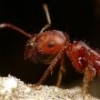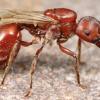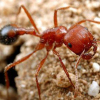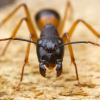I was getting complacent and accidentally pushed a tub against the wall. This gave the argentines the bridge they needed to get onto my ant table. The camponotus and molesta are fine since they are closed boxes. But the pogonomyrmex formicariums I left as open top. They completely decimated the 2019 newly started colony, dragging out and taking all the eggs, larva, and even the 15+ workers. Only 3 queens and 2 workers left in this colony, and one of the queens looks like she won't make it. I moved them into a large test tube for some isolation and recovery.
The 2018 pogonomyrmex subninitidus colony was also attacked hard, but I don't know how much damage there was. I know a few workers got dragged out of the box onto the table and saw a bunch of them including the queen fighting off the invaders in the foraging area top, so I think they may still be ok.
The 20 gallon tank was also attacked, but responded in force and was able to defend their nest effectively due to their numbers.
The argentines also found my mealworm bin and had a buffet there. I just tossed the whole bin in trash.
I cleaned up the table and made sure to leave gaps to prevent access in the future. Lesson learned.





























